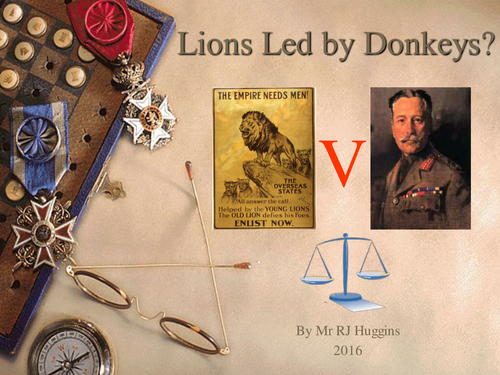

This PowerPoint is designed to span two lessons and includes 6 activities to help students assess the tactics that General Haig used at the Battle of the Somme in 1916. The aims and objectives are:
Theme: Why was there a stalemate on the Western Front?
Know: What tactics did General Haig use at the Battle of the Somme in 1916?
Understand: Why did the Battle of the Somme end in a stalemate?
Evaluate: Was General Haig the 'Butcher of the Somme?
Skills: Cause, Consequence, Source Analysis and Interpretation
WILF: What Am I Looking For?
Identify and describe - What happened during the Battle of the Somme in 1916?
Explain - Why did Haig’s tactics fail to achieve a breakthrough?
Analyse - How far was Haig’s responsible for the failure to break through in 1916?
These activities include a snowballing starter, source analysis comparing John Laffin and the BBC’s Blackadder interpretation of General Haig, a contemporary cartoon analysis to assess public reaction in 1916, a summary diagram of why Haig tactics failed and a source analysis comparing the different perspectives of George Coppard and Haig of the progress made on the first day of the attack. I’ve also included a card sort activity which could be used as the basis for an assessment or extended writing on the topic.
In all there are 40 slides which can be easily customised for your students. It could also be uploaded to a virtual learning environment and used as an independent learning resource for homework.
Professional Knowledge
For those of you who are new to the profession, this topic is controversial for a number of reasons. Firstly, the leadership of the British Army during the war is traditionally described by some historians as ‘lions led by donkeys.’ Please note that this interpretation first grew out a dissatisfaction with the Treaty of Versailles and the concept that the First World War would be the ‘War to end all wars’ in the 1930’s. Clearly by then, many of the sacrifices appeared to have been in vain with the rise of Hitler and the threat of war. However, in the immediate aftermath of the First World War, Haig was seen as a hero. He was also the man who set up the Royal British Legion and began the first poppy appeal. Secondly, this topic is controversial for many of our Australian cousins whose sense of national identity grew out of their frustration and anger over the disaster at Gallipoli. This has led to feeling that the British tactics were a complete failure in all theatres of war and has led to the writing of some pretty bad popular history by Australian tour guides like John Laffin in his book ‘British Butchers and Bunglers of WW1’ to almost justify the Republican Movement in Australia.
Anyway, have fun and I look forward to your feedback.
Get this resource as part of a bundle and save up to 49%
A bundle is a package of resources grouped together to teach a particular topic, or a series of lessons, in one place.
Something went wrong, please try again later.
This resource hasn't been reviewed yet
To ensure quality for our reviews, only customers who have purchased this resource can review it
Report this resourceto let us know if it violates our terms and conditions.
Our customer service team will review your report and will be in touch.
